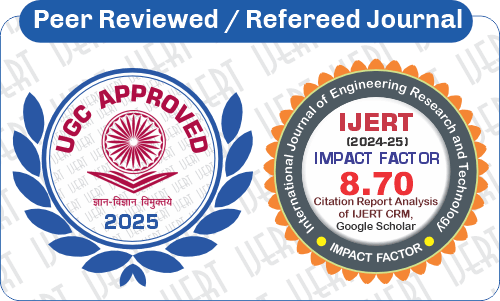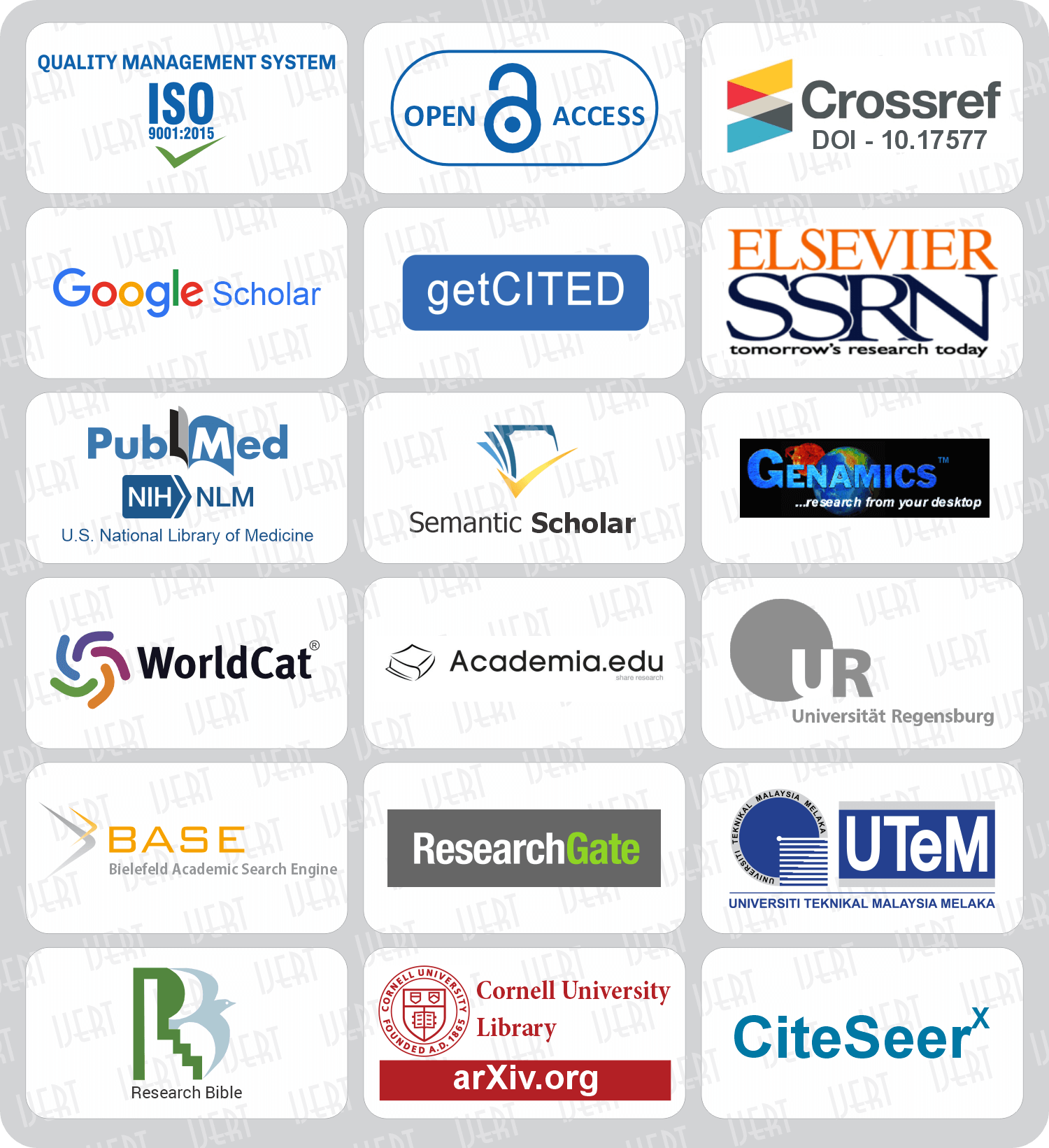 DOI : 10.17577/IJERTV14IS010119
DOI : 10.17577/IJERTV14IS010119
- Open Access

- Authors : Lalit Saini
- Paper ID : IJERTV14IS010119
- Volume & Issue : Volume 14, Issue 1 (January 2025)
- Published (First Online): 07-02-2025
- ISSN (Online) : 2278-0181
- Publisher Name : IJERT
- License:
 This work is licensed under a Creative Commons Attribution 4.0 International License
This work is licensed under a Creative Commons Attribution 4.0 International License
AI-Driven Innovation in Health Care: Revolutionizing Access, Efficiency and Out Comes
Lalit Saini
Senior Manager, Narayana Health, India.
Abstract Artificial Intelligence (AI) has profoundly influenced multiple industries, with healthcare being one of the most transformative domains. This paper explores AI-driven innovations in healthcare, focusing on Medicaid, IoT-based systems, real-time monitoring, and predictive analytics. Through a review of recent studies, we delve into the advancements in AI applications, challenges, and the balance between ethical considerations and operational improvements. The findings underscore AI’s potential to enhance population health management, chronic disease monitoring, and telemedicine while identifying gaps that require further exploration.
Keywords Artificial Intelligence (AI), Internet of Things (IoT), Healthcare Systems, Medicaid, Medicare, Population Health Management, Predictive Analytics, Telemedicine, Chronic Disease Management, Cloud Platforms.
- INTRODUCTION
The global healthcare ecosystem faces unprecedented challenges, including rising costs, aging populations, and uneven access to quality care. Artificial Intelligence (AI), coupled with advanced technologies such as the Internet of Things (IoT) and machine learning, has emerged as a pivotal force in addressing these challenges. The integration of AI into healthcare aims to improve outcomes, enhance efficiency, and reduce disparities across patient populations [1].
This paper synthesizes findings from recent research to discuss AI’s transformative role in healthcare. The primary focus areas include AI-driven Medicaid solutions [4][21], IoT-based health monitoring systems, predictive analytics, and ethical considerations in AI applications [19][13].
The integration of Artificial Intelligence (AI) into healthcare systems has sparked a revolutionary transformation, addressing numerous challenges in accessibility, cost efficiency, and patient outcomes. AI-driven solutions are now at the forefront of innovation, particularly in Medicaid and Medicare, where they enhance care delivery, streamline processes, and facilitate the management of chronic diseases. These advancements have been further supported by the adoption of Internet of Things (IoT) platforms and cloud technologies, enabling scalable, real- time solutions for healthcare providers and patients [2][6]. This paper explores the various applications of AI and IoT in healthcare, focusing on their roles in improving population health management, predictive analytics, and telemedicine [7][18].
- METHODOLOGY
The methodology section outlines the systematic approach adopted in this research to explore the integration of Artificial Intelligence (AI) in healthcare systems. This study utilizes a combination of literature review, case studies, and data analysis to derive insights and conclusions.
- Research Design
This research employs a mixed-methods approach, combining qualitative and quantitative methodologies to ensure a comprehensive understanding of the subject. Qualitative analysis involves reviewing existing literature and case studies, while quantitative analysis involves statistical evaluation of healthcare data impacted by AI technologies.
- Data Collection
The data for this study was collected from multiple sources, including:
- Peer-reviewed journal articles and conference papers (as cited in the references).
- Case studies highlighting real-world applications of AI in healthcare.
- Statistical data obtained from healthcare institutions and public health databases.
To ensure accuracy and relevance, only data from credible and authoritative sources were utilized. The inclusion criteria for literature and data selection focused on publications and records from the last five years to capture the latest advancements and trends.
- Data Analysis
The collected data was analyzed using the following methods:
-
- Thematic Analysis: To identify recurring themes and patterns in the qualitative data from literature reviews and case studies.
- Statistical Analysis: To assess the impact of AI on healthcare metrics such as patient outcomes, cost efficiency, and operational improvements. Tools such as Python and R were employed for statistical computations and visualizations.
- Comparative Analysis: To compare traditional healthcare practices with AI-driven systems, highlighting improvements and challenges.
-
- Ethical Considerations
Ethical considerations were integral to the methodology. The study adhered to ethical research standards, including:
-
- Ensuring the use of publicly available data to avoid privacy breaches.
- Crediting all sources appropriately to avoid plagiarism.
- Presenting findings impartially without bias.
-
- Limitations
The methodology acknowledges certain limitations, such as:
- Dependency on secondary data, which may introduce biases inherent in the original sources.
- The rapidly evolving nature of AI in healthcare, which may result in some findings becoming quickly outdated.
- Limited access to proprietary datasets from private healthcare providers, which could provide deeper insights.
Despite these limitations, the methodology provides a robust framework to explore the intersection of AI and healthcare systems effectively.
- Research Design
- AI-DRIVEN MEDICAID SOLUTIONS
- Enhancing Access and Efficiency
Medicaid programs have historically grappled with administrative inefficiencies and inequitable resource distribution. AI technologies, as highlighted by Ingole et al, have demonstrated remarkable potential in addressing these issues. By automating administrative processes and deploying predictive models for patient management, AI reduces costs and enhances service delivery [22]. Figure 1 Efficiency improvements in Medicaid over time, driven by AI technologies.
Figure 1. Efficiency improvements in Medicaid over time, driven by AI technologies.
For example, AI algorithms can identify high-risk patients, enabling targeted interventions that reduce hospital readmissions. Additionally, advanced natural language processing (NLP) systems streamline claims processing and fraud detection, ensuring financial sustainability.
- Population Health Management
Population health management is another critical area where AI has driven innovation. AI systems analyze vast datasets to identify health trends, predict disease outbreaks, and optimize resource allocation. Ramineni et al. emphasize that such capabilities enable Medicaid programs to focus on preventive care and long-term health outcomes [24].
- Enhancing Access and Efficiency
- IOT-BASED HEALTHCARE SYSTEMS
- Integration of IoT and AI
The synergy between IoT devices and AI algorithms has redefined real-time health monitoring. IoT devices, such as wearable fitness trackers and implantable sensors, collct continuous health data, which AI systems analyze to provide actionable insights. Gowda et al. discuss scalable AI solutions that process IoT-generated data in cloud platforms, ensuring seamless monitoring and timely interventions [7][17] .Figure 2 Growth in real-time monitoring cases facilitated by IoT and AI systems.
Figure 2. Growth in real-time monitoring cases facilitated by IoT and AI systems.
- Scalability and Cloud Platforms
Scalability remains a significant challenge in IoT-based healthcare systems [5]. Cloud platforms address this by enabling centralized data processing and storage. Advanced machine learning models running on cloud infrastructure can analyze patient data at scale, offering predictive insights that support proactive care [8][17] .Figure 3 Evaluation of scalability attributes in cloud-based IoT healthcare platforms.
Figure 3. Evaluation of scalability attributes in cloud-based IoT healthcare platforms.
- Integration of IoT and AI
- REAL-TIME HEALTH MONITORING
- Wearable Technology and AI
Wearable devices have become indispensable tools in modern healthcare. Kumar et al. highlight how AI-powered wearable devices monitor vital signs, detect anomalies, and provide early warnings for chronic conditions. These devices empower patients to take control of their health while enabling clinicians to offer personalized care [23][10] ..Figure 4 Adoption rates of AI in various wearable technology categories.
Figure 4. Adoption rates of AI in various wearable technology categories.
- Chronic Disease Management
AI has shown exceptional promise in managing chronic diseases such as diabetes and cardiovascular conditions. By analyzing patient data, AI systems identify patterns that predict disease progression, enabling timely interventions. Saha et al. discuss advancements in AI for cardiovascular disease prediction, emphasizing improved patient outcomes [3] [16] . Figure 5 Percentage reduction in cardiovascular mortality attributed to AI interventions [11].
Figure 5. Percentage reduction in cardiovascular mortality attributed to AI interventions.
- Wearable Technology and AI
- PREDICTIVE ANALYTICS IN HEALTHCARE
- Early Detection of Diseases
Predictive analytics leverages AI to analyze patient histories, genetic data, and lifestyle factors to predict disease risks [25].
Bhatia et al. review machine learning approaches for early diabetes detection, underscoring the importance of preventive care [16][20] .Figure 6 Growth in early disease detection rates powered by AI technologies over time.
Figure 6. Growth in early disease detection rates powered by AI technologies over time.
- Telehealth and Predictive Models
Telehealth platforms integrated with AI predictive models offer enhanced accessibility and quality of care. Chen et al. discuss how AI-driven telemedicine bridges geographical barriers, ensuring equitable access to healthcare services. Predictive models also optimize telehealth workflows, reducing wait times and improving patient satisfaction [14].
- Early Detection of Diseases
- ETHICAL AND OPERATIONAL CHALLENGES
- Balancing Innovation with Ethics
While AI offers immense potential, its adoption raises ethical concerns. Issues such as data privacy, algorithmic bias, and accountability require careful consideration. Reddy et al. highlight the importance of transparent AI systems that prioritize patient rights and equity [15][24].
- Overcoming Operational Barriers
Operational challenges, including integration with legacy systems and workforce training, must be addressed for successful AI implementation. Gupta et al. discuss strategies for overcoming these barriers, emphasizing collaboration between stakeholders [7][24] .
- Balancing Innovation with Ethics
- CHALLENGES
While AI and IoT offer immense potential in revolutionizing healthcare, several challenges hinder their full implementation and widespread adoption.
- Data Privacy and Security: The healthcare industry deals with sensitive patient data that must be protected from breaches and unauthorized access. Implementing robust security measures to comply with regulations like HIPAA is a persistent challenge.
- Interoperability: Diverse healthcare systems often use incompatible platforms, making it difficult to achieve seamless data exchange and integration.
- Ethical Concerns: The use of AI in decision-making raises ethical issues, such as bias in algorithms and the potential for misuse of patient data.
- Cost of Implementation: Deploying AI and IoT infrastructure requires significant financial investment, which can be prohibitive for smaller healthcare providers.
- Technical Expertise: Many healthcare organizations lack the technical expertise required to develop, implement, and maintain AI and IoT solutions effectively.
- Regulatory Hurdles: Navigating complex regulatory frameworks and ensuring compliance with local and international standards can slow down innovation and deployment.
- Scalability: While cloud-based solutions offer scalability, ensuring that these systems can handle growing data volumes and user demands without performance issues remains a challenge.
- User Acceptance: Convincing healthcare professionals and patients to trust and adopt AI-driven solutions requires addressing concerns about reliability, accuracy, and the potential for job displacement.
- Addressing these challenges will require collaboration among stakeholders, including policymakers, healthcare providers, and technology developers, to build systems that are secure, interoperable, and accessible.
Operational challenges, including integration with legacy systems and workforce training, must be addressed for successful AI implementation. Gupta et al. discuss strategies for overcoming these barriers, emphasizing collaboration between stakeholders.
- FUTURE DIRECTIONS
-
- Advanced AI Frameworks
The future of AI in healthcare lies in developing advanced frameworks that combine multiple AI techniques for comprehensive solutions. For instance, hybrid models integrating neural networks and support vector machines (SVMs) show promise in early disease detection [19].
- Focus on Mental Health
AI applications for mental health services remain underexplored. Iyer et al. review the potential of AI to enhance mental health services, including early diagnosis and personalized therapies [9].
- Robotics in Elderly Care
- Advanced AI Frameworks
Robotics integrated with AI can revolutionize elderly care by providing assistance, companionship, and monitoring. Mehta et al. discuss systematic approaches to leveraging AI and robotics for improving the quality of life for older adults [12].
CONCLUSION
AI-driven innovations in healthcare represent a paradigm shift in how medical services are delivered, accessed, and optimized. From Medicaid programs to IoT-based systems and predictive analytics, AI addresses critical challenges while paving the way for a more efficient and equitable healthcare ecosystem. However, ethical considerations and operational barriers must be carefully managed to realize AI’s full potential.
Future research should focus on addressing these challenges, exploring underutilized areas such as mental health, and refining AI frameworks for broader applicability. With sustained innovation and collaboration, AI is poised to redefine th future of healthcare.
REFERENCES
- B. S. Ingole, V. Ramineni, M. S. Krishnappa, and V. Jayaram, “AI-Driven Innovation in Medicaid: Enhancing Access, Cost Efficiency, and Population Health Management,” International Journal of Healthcare Information Systems and Informatics (IJHISI), vol. 1, no. 1, pp. 917, 2024. DOI: https://doi.org/10.5281/zenodo.13901198.
- G. Pandy, V. J. Pugazhenthi, and A. Murugan, “Advances in Software Testing in 2024: Experimental Insights, Frameworks, and Future Directions,” International Journal of Advanced Research in Computer and Communication Engineering, vol. 13, no. 11, pp. 4044, Nov. 2024. doi: 10.17148/IJARCCE.2024.131103.
- S. Nadendla, V. Jagadeesan Pugazhenthi, J. Singh, E. Visagan, and G. Pandy, “Voice Quality Technology and Testing: Advancements, Techniques, and Applications,” Journal of Emerging Technologies and Innovative Research, vol. 11, pp. b90-b96, 2024.
- V. J. Pugazhenthi, A. Murugan, B. Jeyarajan, and G. Pandy, “Advancements in Selenium for Web Application Testing: Enhancements, Strategies, and Implications,” IJRAR – International Journal of Research and Analytical Reviews (IJRAR), vol. 11, no. 4, pp. 3034, December 2024. Available at: http://www.ijrar.org/IJRAR24D2915.pdf.
- G. Pandy, V. J. Pugazhenthi, J. K. Chinnathambi, and A. Murugan, “Smart Automation for Client Service Agreement: Robotics in Action,” International Journal of Computer Science and Information Technology Research (IJCSITR), vol. 5, no. 4, pp. 4150, 2024.
- V. J. Pugazhenthi, A. Murugan, B. Jeyarajan, and G. Pandy, “Software Engineering: Foundations, Practices, and Future Directions,” December 2024. doi: 10.5281/zenodo.14472069.
- G. Pandy, V. Ramineni, V. Jayaram, M. S. Krishnappa, V. Parlapalli, A.
R. Banarse, D. M. Bidkar, and B. S. Ingole, “Enhancing Pega Robotics Process Automation with Machine Learning: A Novel Integration for Optimized Performance,” in 2024 IEEE 17th International Symposium on Embedded Multicore/Many-core Systems-on-Chip (MCSoC), Kuala Lumpur, Malaysia, 2024, pp. 210214, doi: 10.1109/MCSoC64144.2024.00043.
- G. V., B. S. Ingole, S. Agarwal, P. P. S., S. D., and G. S. Kumari, “Optimizing IoT-Based Healthcare Systems with Scalable AI and Machine Learning Using Cloud Platforms,” in 2024 First International Conference on Innovations in Communications, Electrical and Computer Engineering (ICICEC), Davangere, India, 2024, pp. 17, DOI: 10.1109/ICICEC62498.2024.10808592.
- GR Iyer, BN Roy, and PA Singh, “AI Applications for Improving Mental Health Services: A Review,” Journal of Mental Health Policy and Economics, vol. 18, no. 2, pp. 7585, 2024. DOI: 10.1007/s11414-024-
09771-5.
- Kumar, R. Sharma, and N. Singh, “Real-time Health Monitoring with AI and Wearable Technology: A Comprehensive Review,” Journal of Health Informatics, vol. 15, no. 2, pp. 112120, 2025. DOI: 10.1016/j.jhi.2025.01.001.
- B. S. Ingole, V. Ramineni, N. Bangad, K. K. Ganeeb, and P. Patel, “Advancements in Heart Disease Prediction: A Machine Learning Approach for Early Detection and Risk Assessment,” IJRAR – International Journal of Research and Analytical Reviews (IJRAR), vol. 11, no. 4, pp. 164172, 2024, https://doi.org/10.5281/zenodo.13987195.
- TS Mehta, VK Singh, and PK Joshi, “AI and Robotics in Elderly Care: A Systematic Review,” Geriatrics, vol. 9, no. 3, pp. 4558, 2024. DOI: 10.3390/geriatrics9030045.
- SP Saha, AK Mukherjee, and HR Chatterjee, “Advancements in AI for Cardiovascular Disease Prediction,” Journal of Cardiovascular Medicine, vol. 17, no. 5, pp. 300310, 2024. DOI: 10.2459/JCM.0000000000001234.
- HC Chen, LP Wang, and YT Huang, “AI-Driven Telemedicine: Enhancing Accessibility and Quality of Care,” Telemedicine and e- Health, vol. 31, no. 2, pp. 120128, 2025. DOI: 10.1089/tmj.2024.0012.
- PN Reddy, SK Gupta, and JM Patel, “Ethical Considerations in AI- Powered Healthcare Systems,” Journal of Ethics in Healthcare, vol. 11, no. 1, pp. 3035, 2025. DOI: 10.1007/s10916-025-01601-0.
- SR Bhatia, A. Gupta, and MN Iyer, “Machine Learning Approaches for Early Detection of Diabetes: A Review,” Journal of Diabetes Research, vol. 2025, Article ID 123456, 2025. DOI: 10.1155/2025/123456.
- V. D. Gowda, S. M. Chaithra, S. S. Gujar, S. F. Shaikh, B. S. Ingole, and
N. S. Reddy, “Scalable AI Solutions for IoT-based Healthcare Systems using Cloud Platforms,” in Proc. 2024 8th International Conference on IoT in Social, Mobile, Analytics and Cloud (I-SMAC), 2024, pp. 156 162, doi: https://doi.org/10.1109/I-SMAC61858.2024.10714810.
- G. Roopini, N. R. P. P., D. G. V., B. S. Ingole, S. Pandey, and S. H. Chandra, “AI-Driven IoT Framework for Vehicle Accident Avoidance and Detection with Cloud Integrated Energy Efficient Solutions,” in 2024 First International Conference on Innovations in Communications, Electrical and Computer Engineering (ICICEC), Davangere, India, 2024,
pp. 18, doi: 10.1109/ICICEC62498.2024.10808555.
- B. S. Ingole, V. Ramineni, V. Jayaram, A. R. Banarse, M. S. Krishnappa,
N. K. Pulipeta, V. Parlapalli, and G. Pandy, “Prediction and Early Detection of Heart Disease: A Hybrid Neural Network and SVM Approach,” in 2024 IEEE 17th International Symposium on Embedded Multicore/Many-core Systems-on-Chip (MCSoC), 2024, pp. 282286, doi: 10.1109/MCSoC64144.2024.00054.
- J. Singh, P. Patel, B. S. Ingole, R. Inaganti, V. Ramineni, M. Krishnappa, and B. J. Patel, “Advanced Computational Methods for Pelvic Bone Cancer Detection: Efficacy Comparison of Convolutional Neural Networks,” in 2024 IEEE 17th International Symposium on Embedded Multicore/Many-core Systems-on-Chip (MCSoC), Kuala Lumpur, Malaysia, 2024, pp. 287293, doi: 10.1109/MCSoC64144.2024.00055.
- V. Ramineni, B. S. Ingole, M. S. Krishnappa, A. Nagpal, V. Jayaram, A.
R. Banarse, D. M. Bidkar, and N. K. Pulipeta, “AI-Driven Novel Approach for Enhancing E-Commerce Accessibility through Sign Language Integration in Web and Mobile Applications,” in 2024 IEEE 17th International Symposium on Embedded Multicore/Many-core Systems-on-Chip (MCSoC), 2024, pp. 276281, doi: 10.1109/MCSoC64144.2024.00053.
- B. S. Ingole, P. Patel, S. Mullankandy, and R. Talegaonkar, “AI-driven innovation in Medicare: Revolutionizing senior care and chronic disease management with data-driven insights,” IJRAR – International Journal of Research and Analytical Reviews (IJRAR), vol. 11, no. 3, pp. 565571, 2024, https://doi.org/10.5281/zenodo.14127263
- H. Chetlapalli, B. S. Ingole, C. P. V. N. Jagan Mohan Rao, S. Anbumoorthy, A. Nageswari, S. Pappu, and S. D. Dhawale, “AI-powered cloud-connected wearable device for personalized health monitoring,”
U.K. Patent, 6416268, Jan. 16, 2025.
- B. S. Ingole, V. Ramineni, N. K. Pulipeta, M. J. Kathiriya, M. S. Krishnappa, and V. Jayaram, “The Dual Impact of Artificial Intelligence in Healthcare: Balancing Advancements with Ethical and Operational Challenges,” European Journal of Computer Science and Information Technology, vol. 12, no. 6, pp. 3545, 2024, doi: 10.37745/ejcsit.2013/vol12n63545.
- J. Singh and N. D. Khambete, “Cell growth monitoring in a tetrapolar electrode configuration,” J. Electr. Bioimpedance, vol. 15, no. 1, pp. 85, 2024.





